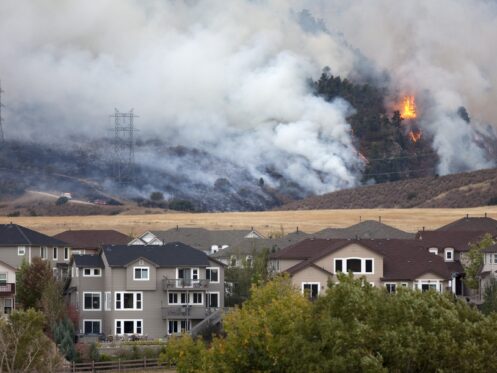Wildfire smoke can slip through cracks and vents, turning your home into a haze-filled trap. You need a plan to filter out fine particles, maintain balanced airflow, and prevent irritants from circulating. At General Air Conditioning & Plumbing, in Palm Springs, CA, we guide homeowners through every filter swap and system tweak to keep indoor air clear when smoke drifts close.
Understanding Smoke Particles and Their Impact
Wildfire smoke contains particles so small they slip past common filters and lodge deep in your lungs. Those PM2.5 particles measure less than 2.5 microns and carry toxins from burning vegetation, plastics, and buildings. When you inhale that air, you might notice scratchy throats, tight chests, or sudden coughing. Children and older adults react more strongly when those particles circulate indoors. Knowing how smoke behaves helps you tackle it correctly. Rather than trust a standard filter, choose media or high-efficiency options rated for capturing ultrafine dust.
Plan your HVAC system’s runtime around those windows, keeping the system in recirculation mode with doors and windows closed until the outdoor air clears. Understanding that smoke sneaks through vents and gaps in ductwork will encourage you to seal those leaks and keep your living space truly protected.
Managing Ventilation During Air Quality Alerts
Shutting down fresh-air intakes makes sense when the sky fills with smoke, but keeping a stale house can feel uncomfortable. If you have a balanced ventilation system, switch it to exhaust-only mode to remove odors and excess humidity without drawing in outside hazards. Heat recovery ventilators and energy recovery ventilators can temporarily bypass their outdoor side while keeping indoor air moving through filters.
Program your thermostat schedule to cycle fan-only periods during midday lulls when air quality improves. That sweeps interior air through filters without activating your heating or cooling. Pay attention to shifts in wind direction reported by local air-quality indices. If smoke drifts north in the morning, open a few windows on the south side briefly, then close them before the worst air arrives. Those small flushes of fresher air can relieve stuffiness without letting in heavy smoke.
Leveraging Portable Air Cleaners
When your HVAC system can’t handle all areas equally, set up portable air cleaners with True HEPA filters in the rooms you use most. Place one near your workstation or sleeping area to trap smoke before it drifts into your personal zone. Check the unit’s Clean Air Delivery Rate and choose a model sized for the room’s square footage. Run it on its highest setting for the first hour to clear existing particles, then dial it back to medium to maintain cleanliness without excess noise. Keep doors closed around the cleaner’s location so it can cycle air efficiently. Change its prefilter monthly during smoke season and its HEPA filter every six months or as the manufacturer recommends.
Controlling Humidity to Aid Filtration
High humidity can make smoky air feel heavier and increase pollutant adherence to surfaces. Aim for relative humidity between 40 and 50% to keep your filters working at peak efficiency. A humidifier in your ductwork can raise moisture when the air drops below 30%, but switch it off when you see rain or higher outdoor humidity.
Conversely, adding a dehumidifier module helps pull excess moisture when levels climb above 50%. That balance stops mold from forming on damp surfaces while making particles less sticky, so filters capture them more easily. Monitor humidity with a small digital hygrometer placed in your living area. If the reading drifts out of range, schedule a quick pro visit to recalibrate your humidistat or dehumidistat. Keeping humidity steady not only improves comfort but also supports your indoor air-cleaning strategy during smoky spells.
Sealing Ducts and Closing Gaps
Invisible leaks in your ductwork allow smoke-laden air from attics or crawlspaces to creep into living rooms. A professional duct sealing assessment uses a blower test to pressurize the network and reveal gaps with smoke pencils or infrared imaging. Addressing those leaks stops unfiltered air from bypassing your HVAC system’s main filter. Technicians apply UL-rated mastic sealant along seams and secure flexible ducts with metal collars to prevent disconnections. They also seal around registers and plenum connections so conditioned air travels only through closed, filtered paths.
While this work may require access panels or brief furniture moves, the result is a tighter system that channels all air through upgraded filters. In addition, if you have noticed uneven heating or cooling, the same fixes that seal out smoke also balance airflow, giving you long-term performance gains beyond wildfire season.
Monitoring Indoor Air Quality Day to Day
Tracking your home’s air in real time takes the guesswork out of filter changes and fan schedules. Invest in a small indoor air monitor that measures particle counts, carbon dioxide, and relative humidity. Place it on a desk or countertop away from direct airflow so it reads typical conditions.
Many models display an index that turns green for good, yellow for moderate, and red for poor air quality. If you see the indicator climb into red, trigger your high-efficiency filtration and start a portable air cleaner. Record peak readings in a simple log to see patterns, such as early-morning spikes during nearby burns or afternoon surges when smoke drifts overhead. Sharing those logs with an HVAC pro can help them fine-tune your system’s fan schedules or suggest additional filtration solutions tailored to how smoke behaves around your home.
Preparing Your HVAC System Before Fire Season
A quick pre-season tune-up keeps your heating and cooling gear ready for high-duty air filtration. Schedule a professional inspection in late summer to clean coils, check blower motors, and verify damper operation. Technicians can replace belts, tighten electrical connections, and test your system’s airflow under load. They’ll also review your filter rack and recommend any upgrades to MERV 13 or higher media based on your model’s capacity.
If your system lacks the static pressure margin for dense filters, they may suggest an inline booster fan or a standalone air cleaner inside the duct. Consider enrolling in a seasonal service plan that includes fall HVAC system checks and emergency filter delivery, so when an air quality alert starts, you’re already set to breathe easier.
Emergency Steps When Smoke Intrudes
If a sudden wind shift drives thick smoke toward your neighborhood, take immediate action to protect indoor air. Close all windows, switch your HVAC system to recirculation mode, and engage your high-efficiency filter. Place portable cleaners in occupied rooms and set them to high. Use thick towels or weatherstripping to seal gaps under exterior doors.
If you have a fireplace, shut its damper fully and close any outdoor air intakes dedicated to combustion appliances. Unplug attic fans or exhaust vents that might draw smoke in. Keep interior doors between hallways and living areas open so air cleaners can circulate most effectively. These rapid moves limit smoke infiltration until air quality indexes return to safer levels and allow your home to function as a cleaner holdout against the haze outside.
Breathe Better This Fire Season
Your indoor air quality doesn’t have to suffer when wildfires rage nearby. Simple actions, upgrading to higher-grade filters, scheduling quick HVAC system tune-ups, and adding whole-home air cleaners, make a real difference in what you and your family breathe. At General Air Conditioning & Plumbing, we handle duct sealing, humidity control, and professional filter installations to lock out outdoor pollutants and keep your system running smoothly.
Ready to lock down your indoor air? Call General Air Conditioning & Plumbing today to schedule your wildfire-season HVAC checkup.


